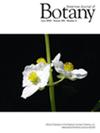An evolutionary disruption of the buzz pollination syndrome in neotropical montane plants
Abstract
Premise
Under pollinator limitations, specialized pollination syndromes may evolve toward contrasting responses: a generalized syndrome with increased pollinator attraction, pollinator reward, and pollen transfer capacity; or the selfing syndrome with increased self-pollen deposition, but reduced pollinator attraction and pollen transfer capacity. The buzz-pollination syndrome is specialized to explore female vibrating bees as pollinators. However, vibrating bees become less-active pollinators at montane areas of the Atlantic Forest (AF) domain. This study investigated whether the specialized buzz-pollination syndrome would evolve toward an alternative floral syndrome in montane areas of the AF domain, considering a generalized and the selfing syndromes as alternative responses.
Methods
We utilized a lineage within the buzz-pollinated Miconia as study system, contrasting floral traits between montane AF-endemic and non-endemic species. We measured and validated floral traits that were proxies for pollinator attraction, reward access, pollen transfer capacity, and self-pollen deposition. We inferred the evolution of floral trait via phylogenetic comparative methods.
Results
AF-endemic species have selectively evolved greater reward access and more frequently had generalist pollination. Nonetheless, AF-endemic species also have selectively evolved toward lower pollen transfer capacity and greater self pollination. These patterns indicated a complex evolutionary process that has jointly favored a generalized and the selfing syndromes.
Conclusions
The buzz pollination syndrome can undergo an evolutionary disruption in montane areas of the AF domain. This floral syndrome is likely more labile than often assumed, allowing buzz-pollinated plants to reproduce in environments where vibrating bees are less-reliable pollinators.

 求助内容:
求助内容: 应助结果提醒方式:
应助结果提醒方式:


